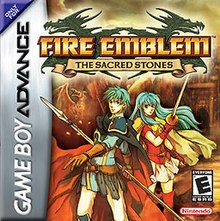| Fire Emblem: The Sacred Stones | |
|---|---|
 North American box art | |
| Developer(s) | Intelligent Systems[a] |
| Publisher(s) | Nintendo |
| Director(s) | Sachiko Wada Taiki Ubukata Kentaro Nishimura |
| Producer(s) | Toru Narihiro Hitoshi Yamagami |
| Programmer(s) | Hiroyuki Fujiwara |
| Artist(s) | Sachiko Wada Ryo Hirata |
| Writer(s) | Kouhei Maeda |
| Composer(s) | Yoshihiko Kitamura Saki Haruyama Yoshito Hirano |
| Series | Fire Emblem |
| Platform(s) | Game Boy Advance |
| Release | |
| Genre(s) | Tactical role playing |
| Mode(s) | Single-player, multiplayer |
Fire Emblem: The Sacred Stones[b] is a tactical role-playing game developed by Intelligent Systems, and published by Nintendo for the Game Boy Advance handheld video game console in 2004 for Japan and 2005 in the West. It is the eighth entry in the Fire Emblem series,[c] the second to be released outside Japan, and the third and final title to be developed for the Game Boy Advance after The Binding Blade and its prequel Fire Emblem.
Set in a separate continuity to earlier Fire Emblem titles, The Sacred Stones takes place on the fictional continent of Magvel, which is divided into five nations, each built around a magical stone said to be linked to the imprisonment of an ancient demon. When one of the five nations, the Grado Empire, invades its neighbors and begins destroying the stones, protagonists Eirika and Ephraim of the royal family of Renais set out to gather allies and halt Grado's conquest, while also trying to uncover the reasons for the war. The gameplay is similar to previous Fire Emblem games, focusing on turn-based, tactical movement of units across a grid-based battlefield. Core features of the game include permanent death for characters defeated in battle and support conversations that grant advantages to certain units in battle.
The Sacred Stones began development alongside Fire Emblem: Path of Radiance as a side project, sharing much of its visual design and mechanics with Fire Emblem while incorporating elements from earlier entries such as Fire Emblem Gaiden. First announced in mid-2004, it was heavily promoted in Japan. When released, it sold over 230,000 units during 2004, with a further 90,000 being sold upon its North American debut. Reception was positive overall for its story and gameplay, although many critics cited it as being too similar to its predecessor. The Sacred Stones would be the last original handheld Fire Emblem title until Fire Emblem Awakening for the Nintendo 3DS in 2012.
Cite error: There are <ref group=lower-alpha> tags or {{efn}} templates on this page, but the references will not show without a {{reflist|group=lower-alpha}} template or {{notelist}} template (see the help page).
- ^ Cite error: The named reference
TSSreleasewas invoked but never defined (see the help page). - ^ "Iwata Asks: Fire Emblem: Shadow Dragon". Fire Emblem: Shadow Dragon Official Website. 2008. Archived from the original on November 4, 2010. Retrieved July 17, 2015.
- ^ ファイアーエムブレムワールド 【FIRE EMBLEM WORLD】 - Series. Fire Emblem World. Archived from the original on April 17, 2015. Retrieved July 17, 2015.
- ^ 社長が訊く『ファイアーエムブレム 新・紋章の謎 ~光と影の英雄~』. Nintendo. 2010. Archived from the original on July 13, 2015. Retrieved July 12, 2016.